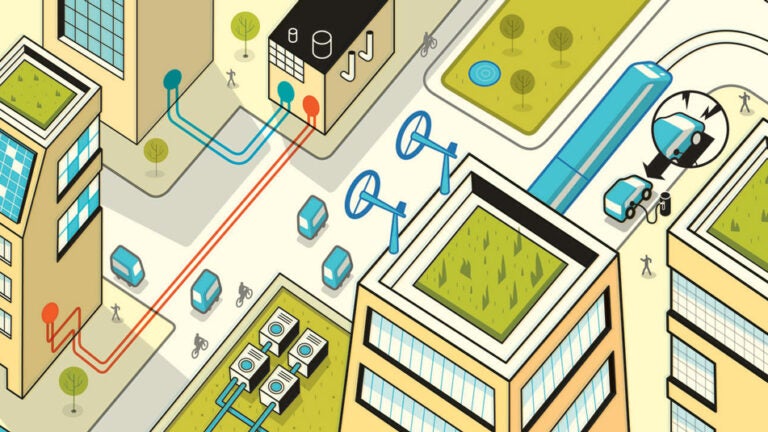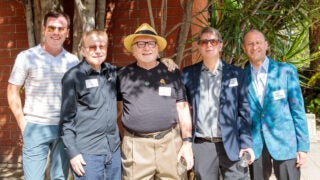
(Illustration/Harry Campbell)
Off the Field, USC and UCLA Make for a Better Los Angeles Together
Bruins and Trojans can all get along when it comes to creating a livable urban future.
Though their staunch football rivalry dates back to 1929, USC and UCLA can put their fierce competition aside when the conversation turns to improving the city they both call home. The two universities have joined other leading Southern California academic and research institutions like Caltech to make Los Angeles County a hotbed for solving urban issues.
The United Nations has predicted that three-fourths of the world’s people will live in cities by 2050. With that movement come growing challenges in transportation, sustainability and more. The COVID-19 pandemic may have slowed the pace of urban migration, but experts believe the flow will continue. As urbanization grows, USC’s and UCLA’s collaborations aim to build a better future for Angelenos and offer lessons for the megacities to come.
No going back: measuring the impact of COVID-19
As COVID-19 blazed through Los Angeles County in 2020, it revealed the stark socioeconomic disparities afflicting the region. Blacks and Latino workers are disproportionately employed in essential jobs like janitorial, retail and health care work, which heightens their risk of exposure. Almost 20% of Angelenos are undocumented or living with someone who is, which reduces their access to benefits like food stamps or unemployment checks. Some 40% of Black and Latino children have no access to a computer and high-speed internet, making them more likely to fall behind with remote learning.
The Equity Research Institute at the USC Dornsife College of Letters, Arts and Sciences teamed up with UCLA’s Luskin School of Public Affairs to make sense of these inequities and chart a better path forward.
To close the digital divide, USC and UCLA experts recommend that the county establish internet as a public utility and provide low-cost rates to residents. To provide economic recovery to marginalized communities, procurement processes should be streamlined to make it easier for small businesses, often owned by people of color, to apply for contracts. The report also recommends ongoing, alternative forms of assistance for undocumented immigrants, such as the Angeleno Campaign, which provided funds to residents regardless of legal status.
UCLA brought clear assets, including its talented faculty and graduates and its expertise at policy analysis. But it was also important symbolically to show that the region’s two top universities could and should collaborate for the public good.
Manuel Pastor
For Manuel Pastor, Distinguished Professor of Sociology and American Studies and Ethnicity at USC Dornsife and director of the institute, the collaboration between USC and UCLA both strengthened the content of their report and served as a model for how competing institutions could set aside differences.
“UCLA brought clear assets, including its talented faculty and graduates and its expertise at policy analysis. But it was also important symbolically to show that the region’s two top universities could and should collaborate for the public good,” he says.
“An added bonus: We could begin every briefing with the two lead primary investigators — myself from USC and Gary Segura from UCLA — teasing each other and commenting that if we could get together, peace in the Middle East was also possible.”
Planes, trains and automobiles: getting people where they need to go
Arizona, California, Hawaii and Nevada are home to more than 50 million people. They also have some of the most visited U.S. cities, four of the nation’s 10 busiest airports and the country’s largest port complex.
Overseeing nearly all these bustling hubs is the Pacific Southwest Region University Transportation Center (PSR), led by the METRANS Transportation Center, a joint partnership between USC and Cal State Long Beach. The center strives to improve the movement of people and goods around the region through research, education and outreach.
PSR collaborator UCLA plays a significant role by collaborating on research and by publishing PSR’s biannual digital magazine Transfers, which ensures that their work reaches a broad public audience. The most recent issue details research on how living near warehouses affects the poor, what governments can learn from Hawaii about encouraging the adoption of electric vehicles and how employers can help influence transportation choices beyond the daily commute.
This relationship between USC and UCLA is also forging valuable connections.
“Students from both universities attend seminars and webinars, participate in our Emerging Scholars PhD showcase and professional development activities together, and compete in activities like hackathons,” says Genevieve Giuliano, the Margaret and John Ferraro Chair in Effective Local Government at the USC Price School of Public Policy and director of the center. “These interactions are particularly beneficial for the graduate students — they meet peers and faculty, add to their networks and develop new collaborations.”
A shared vision: fostering innovation and entrepreneurship
Bring creative entrepreneurs and problem-solvers together and ideas happen. As the nation’s second-most-populous city, Los Angeles draws its share of innovators. An effort called Innovation Node-Los Angeles (IN-LA) brings some of their ideas to life.
IN-LA is a collaboration among USC, UCLA and Caltech. It provides workshops, networking and skill-building opportunities to scientists who want to commercialize their work.
IN-LA is a collaboration among USC, UCLA and Caltech. It provides workshops, networking and skill-building opportunities to scientists who want to commercialize their work. The National Science Foundation funds the effort.
Through the network, scientists have gotten assistance in developing technology that stores heat energy more effectively, a big-city sustainability problem. Others have advanced technology that extends the life of streets and highways or that proposes more effective cells for absorbing solar energy.
Some of the tech relates to health. Niki Bayat PhD ’18, who studied chemical engineering at USC, aims to help people with dry eye syndrome. This persistent problem can cause scarring and blurred vision and is behind 25% of ophthalmology visits. Current treatments can be costly and require multiple visits to the doctor. But Bayat’s company, AesculaTech, created an alternative treatment that preserves the eye’s natural tears.
AesculaTech received a $50,000 grant administered by IN-LA and an invitation to the prestigious startup accelerator Y-Combinator after participating in the network’s seminars.
Collaborating with UCLA has ensured the network has plenty of skilled mentors for the entrepreneurs who seek out its programs, says Yannis C. Yortsos, dean of the USC Viterbi School of Engineering and principal investigator at IN-LA. “Mentors play a huge role in developing a company and adopting best practices,” he says.
By building together rather than competing for resources, the two institutions help make the city an attractive place for innovation to emerge. Each year, the program trains 75 to 100 teams of entrepreneurs. “USC and UCLA are part of an ecosystem, and growing the ecosystem is very important,” Yortsos says. “If there’s a strong ecosystem, then it attracts interest, capital and talent.”
Bayat’s technology, called Humidifeye, could be one of Innovation Node-Los Angeles’ biggest success stories. It’s on track to be reviewed by the U.S. Food and Drug Administration this year.



